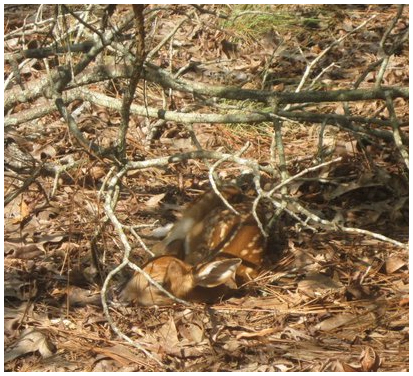
Rescues may do more harm than good
This time of year, the Florida Fish and Wildlife Conservation Commission (FWC) begins getting calls about “abandoned” baby wild animals that well-meaning people believe are in need of rescue. These rescues are unnecessary, and they actually may do more harm than good.
After giving birth, adult wildlife must forage to provide food for themselves and their young. That requires the adult animals to leave their newborns for short periods. The little one may look like it’s been abandoned, but that seldom is the case.
Common targets of unnecessary rescues are baby deer, temporarily left in a safe place while their mothers feed nearby.
“In most cases, it is absolutely not in the fawn’s best interest to try and rescue it,” said Allan Hallman, wildlife biologist at the FWC’s Camp Blanding field office.
Hallman says what typically happens is someone discovers a young deer waiting for its mother. Often, people stumble onto fawns in palmetto patches or in recently burned areas, where a doe has placed her new offspring for protection. These settings tend to help mask the fawn’s scent, thus providing good protection from the keen nose of a predator.
People discover these seemingly abandoned baby deer and become concerned when the parent is nowhere in sight. The would-be rescuers falsely believe the young animal will perish unless they save it or take it to a wildlife rehabilitation center.
“Unfortunately, actions of this kind usually have the opposite effect of a rescue,” Hallman said. “The stress created by changing the animal’s diet and surroundings is often fatal.
“If the rescued fawn manages to survive, its return to the wild is practically impossible because of human imprinting or a lack of survival skills. If it had remained wild, the young deer would have learned the necessary survival skills from its mother,” Hallman said.
Another way to help with the survival of the young animals is to not feed them. Although that may sound odd, feeding can cause problems – ranging from poor nutrition to making the animal dependent on humans for food to loss of foraging skills – all of which can decrease the critter’s chances of survival.
“These animals have survived for a long time without assistance. They can continue to survive without handouts,” Hallman said.
The FWC recommends that if you find a fawn or other baby animal, don’t touch it, and quietly leave the area. Touching the animal may cause the mother to reject it because it is contaminated with human scent.
On the other hand, songbirds have almost no sense of smell and can be returned to their nest without much chance of rejection. Young songbirds are commonly found on the ground at this time of year, looking a bit dazed or confused. The youngster may be trying to hide in tall grass or in low bushes to avoid being seen by predators. These young birds are going through a process called fledging.
When they’re ready to fledge, young birds have grown all the adult feathers they’ll need to fly, but they still must learn to fly. During this process, the immature birds sometimes end up on the ground, where they may spend several days before they learn all their flight skills.
“While on the ground, the juvenile birds’ parents watch over them, feeding them and helping them learn necessary survival skills. Pet owners can help protect vulnerable young birds by keeping dogs and cats away from them,” Hallman said. “Please don’t interfere in this crucial learning process.”
Here are some important facts that can help determine if a baby bird needs rescuing. According to biologists, the only time a baby songbird should be rescued is when it is on the ground and has almost no feathers, when the bird is injured by pets or its tail is less than a half-inch long and it cannot hop around on its own.
If you find a baby songbird you are sure needs rescuing, place the baby bird in a tissue-lined box that has air holes in the top. Keep the box in a warm spot away from drafts and air conditioning and out of direct sunlight. Do not give it food or water. Call a licensed wildlife rehabilitator in your area. The FWC’s regional offices have lists of local rehabbers. Many local veterinarians also work closely with wildlife rehabilitators and also can be a good source of advice.
Another suggestion is to place the bird in a lined box and attach the box to the tree from where the bird fell. Sometimes the parents will come to the baby in the new box and feed it there. This gives the birds a chance to be raised properly by their parents.
“Most parents will come back to care for the fledgling. Sometimes, however, they reject the chick because of a limited food supply, an inability to care for the young chick, or for other reasons we may not understand,” Hallman said. “If the parents don’t return, then the chick should be taken to a rehab center. Migratory birds are protected and need to be cared for by a licensed facility.”
The FWC asks you to remember that removing an animal from the wild to save it may actually have the opposite effect. Seek advice from wildlife professionals before attempting to rescue any animal, and remember: in most cases, it is better to leave wildlife wild.
For more information on Florida’s wildlife and what you can do to help, go to MyFWC.com/Wildlife and click on “Living with Wildlife.”
